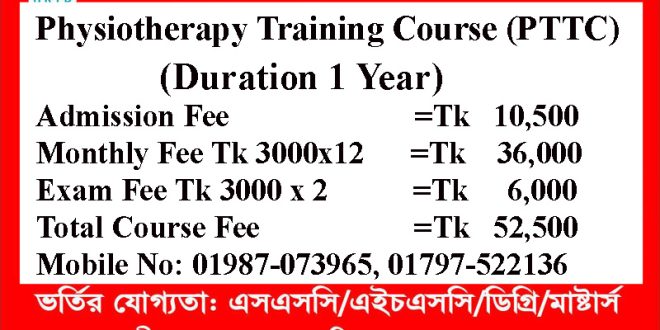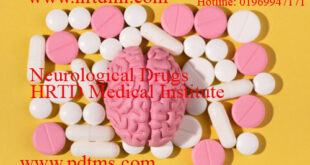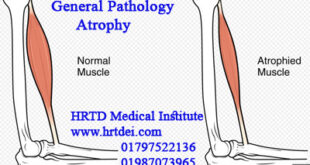Physiotherapy Training Course Profile Details:
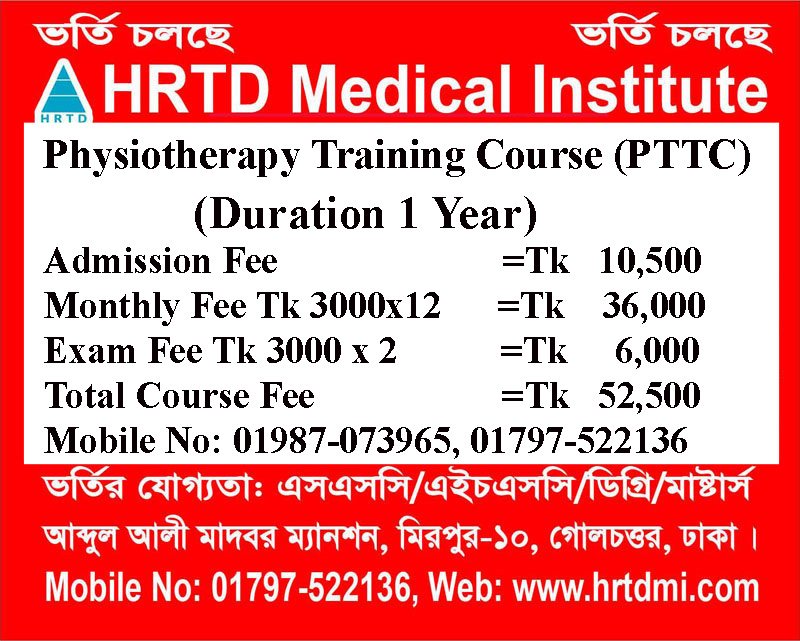
Physiotherapy Training Course (PTTC) 1 Year: Mobile No: 01987-073965, 01797-522136. This short course of Physiotherapy contains 10 subjects in 2 semesters. 1st Semester contains 5 subjects. The subjects are Human Anatomy & Physiology, Chemistry & Pharmacology, First Aid & Treatment, Hematology & Pathology, and the Study of OTC Drugs & Medicine.
2nd semester of this short physiotherapy course contains 5 subjects. The subjects are Orthopedic anatomy & Physiology, Neuroanatomy & Physiology, Cardiovascular Anatomy & Physiology, Electro Physics, and the Study of TENS.
Course Fee Summary:
Course fee for 1 year Physiotherapy Training Course Tk 52,500/- including admission fee Tk 10,500/-, Monthly fee Tk 3000/- and exam fee Tk 3000×2 = 6000/-.
Our Others Course:
Pharmacy Course, Dental Course, Nursing Course, Pathology Course, Homeopathy Course, Veterinary Course, Village Doctor Course, PDT( Post Diploma Training) Course, PPT, LMAF Training Course, LMAFP Course, Poultry Course, DMA ( Diploma Medical Assistant), Diploma in Medicine and Surgery (DMDS).
HRTD Medical Institute, located in the heart of Dhaka, is proud to announce the launch of its Physiotherapy Training Center. With a commitment to providing quality healthcare education, the Institute is dedicated to producing skilled physiotherapists who can provide the best possible care to patients.
The Physiotherapy Training Center offers a comprehensive curriculum that covers all aspects of physiotherapy, including anatomy, physiology, biomechanics, manual therapy, exercise therapy, and rehabilitation. Our experienced and knowledgeable faculty members, who have years of experience in the field, will provide students with hands-on training and practical experience through clinical placements.
Our state-of-the-art facilities include well-equipped lecture halls, anatomy and physiology labs, and a clinical skills lab, where students can practice various physiotherapy techniques under the supervision of qualified instructors. Additionally, the Institute has established partnerships with leading healthcare organizations, allowing students to gain practical experience in real-world settings.
At the end of the program, graduates will be equipped with the knowledge and skills necessary to work as physiotherapists in a variety of settings, including hospitals, rehabilitation centers, sports clinics, and private practices. Our graduates will also be eligible to sit for the national licensure examination, which will allow them to practice physiotherapy in Bangladesh and abroad.
We believe that every patient deserves access to high-quality physiotherapy care, and it is our mission to produce physiotherapists who can provide that care. If you are interested in pursuing a career in physiotherapy and are looking for a comprehensive training program, we invite you to join us at HRTD Medical Institute’s Physiotherapy Training Center. Enroll now and take the first step towards a fulfilling career in healthcare.
Location of Physiotherapy Training Course
Location of Physiotherapy Training Course. Mobile Phone Number 01797522136, 01987073965. HRTD Medical Institute, Section-6, Block-Kha, Road-1, Plot-11, Metro Rail Piller No. 249, Mirpur-10 Golchattar, Dhaka-1216. Mobile Phone No. 01797522136, 01987073965.
Objectives of Physiotherapy Course
একজন ফিজিওথেরাপিষ্ট এর পক্ষে একটি ফিজিওথেরাপী চেম্বার বা ফিজিওথেরাপী সেন্টার বা ফিজিওথেরাপী ক্লিনিক ম্যানেজ করা সম্ভব হয় না বা ম্যানেজ করা উচিৎ না । কারন সেখানে থাকে অনেক মেশিনারী এবং অনেক কাজ । যেমন মেশিনারী ম্যানেজমেন্ট, মার্কেটিং ম্যানেজমেন্ট, একাউন্টস ম্যানেজমেন্ট, ফিনেনশিয়াল ম্যানেজমেন্ট, রোগীদের ডেটা ম্যানেজমেন্ট, রোগীদের কাউন্সিলিং ইত্যাদি ।
ফিজিওথেরাপি কোর্স করার পর শিক্ষার্থীরা-
(১) ফিজিওথেরাপি সম্পর্কিত অনেক জ্ঞান ও দক্ষতা অর্জন করতে পারবে ।
(২) বিভিন্ন ফিজিওথেরাপি সরঞ্জাম এবং আনুষাঙ্গিক পরিচালনা এবং রক্ষণাবেক্ষণের জ্ঞান ও দক্ষতা অর্জন করতে পারবে ।
(৩) ফিজিওথেরাপি সম্পর্কিত প্রয়োজনীয় ডকুমেন্টেশন বজায় রাখার জ্ঞান ও দক্ষতা অর্জন করতে পারবে ।
(৪) ফিজিওথেরাপি যন্ত্রগুলি পরিচালনার বিপদ এবং তাদের প্রতিরক্ষামূলক জ্ঞান ও দক্ষতা অর্জন করতে পারবে ।
(৫) ফিজিওথেরাপিউটিক কার্যক্রম তদারকি জ্ঞান ও দক্ষতা অর্জন করতে পারবে ।
(৬) ফিজিওথেরাপিউটিক কার্যক্রমের ভবিষ্যত উন্নয়ন ও পরিকল্পনায় অবদান রাখাতে পারবে।
Class Time for 1 Year Physiotherapy Training Course
Weekly Class 3 hours. For Regular Students Friday 1 hour, Saturday 1 hour, and Monday 1 hour. For Job holders, Friday is 3 hours, or Monday is 3 hours. Morning Shift 9:00 am to 12:00 pm, and Evening Shift 3:00 pm to 6:00 pm.
Teacher of 1 Year Physiotherapy Training Course
Dr. Md. Sakulur Rahman, MBBS, CCD
Dr. Benzir, MBBS, FCPS (FP)
Dr. Farhana Sharna, MBBS
Dr. Amena Afroze Anu, MBBS, PGT
Dr. Rayhan, BPT
Dr. Abu Hurayra, BPT
Dr. Tanzila, MBBS
Dr. Shamima, MBBS, PGT
Dr. Tisha, MBBS, PGT
Dr. Anika, MBBS, PGT
Subjects for 1 Year Physiotherapy Training Course
1st Semester Subject:
Human Anatomy & Physiology
Chemistry & Pharmacology
First Aid & Treatment
Hematology & Pathology
Orthopedic Anatomy & Physiology
2nd Semester Subject:
Neuro Anatomy & Physiology
Orthopedic Disease & Complication
Therapeutic Exercise
Electro Physics
Electrotherapy
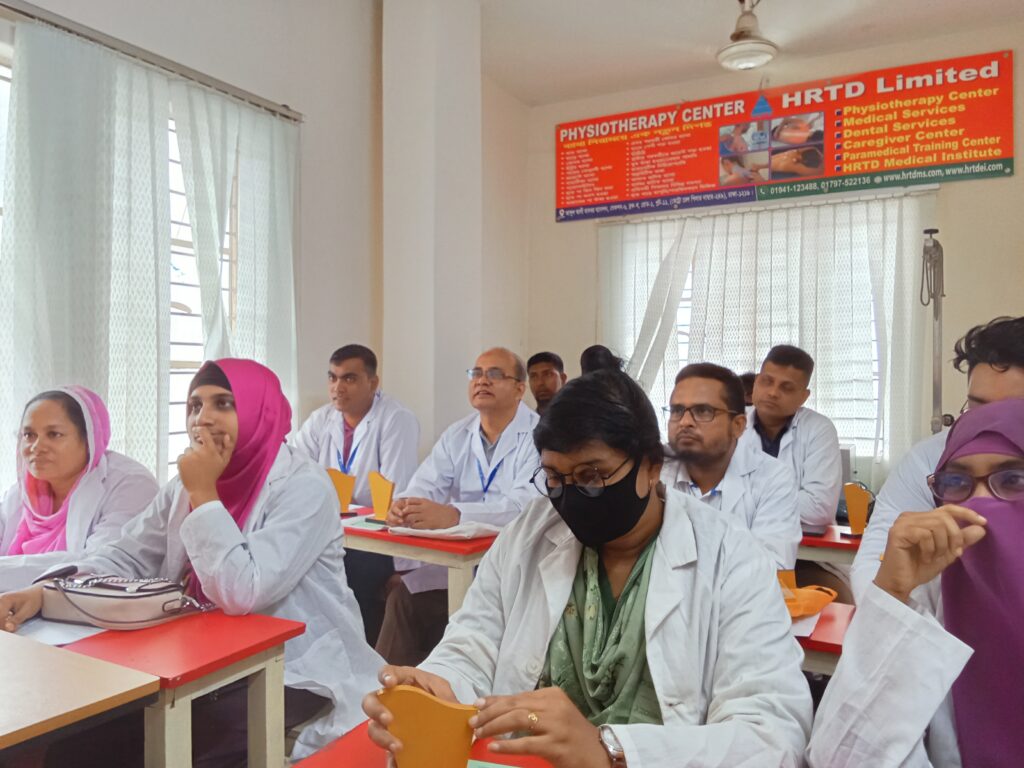
Human Anatomy & Physiology for 1 Year Physiotherapy Training Course
Human Anatomy & Physiology is an important subject in physiotherapy courses. The study of Body Structure and its functions is Anatomy and Physiology. Here we discuss the systems of the Human Body and its Organs, Tissues, and Cells. The systems of the Human Body are the Nervous System, Digestive System, Respiratory System, Circulatory System or Cardiovascular System, Skeletal System, Muscular System, Endocrine System, Immune System, Lymphatic System, Integumentary System or Covering System, and Urinary System.
শারীরিক গঠন এবং এর কার্যাবলীর অধ্যয়ন হল অ্যানাটমি এবং ফিজিওলজি। এখানে আমরা মানবদেহের সিস্টেম এবং এর অঙ্গ, টিস্যু এবং কোষ নিয়ে আলোচনা করি। মানবদেহের সিস্টেমগুলি হ’ল হজম সিস্টেম, শ্বাসযন্ত্র, কার্ডিওভাসকুলার সিস্টেম, কঙ্কাল সিস্টেম, পেশীতন্ত্র, স্নায়ুতন্ত্র, এন্ডোক্রাইন সিস্টেম, ইমিউন সিস্টেম, লিম্ফ্যাটিক সিস্টেম, ইন্টিগুমেন্টারি সিস্টেম এবং ইউরিনারি সিস্টেম।
What is Anatomy & Physiology?
- Anatomy → Study of body structures (bones, muscles, organs, nerves, vessels, etc.).
- Physiology → Study of how these structures function and work together.
In physiotherapy, both are essential to understand movement, posture, exercise, and rehabilitation.
Major Systems to Study
1. Skeletal System (Bones & Joints)কঙ্কালতন্ত্র
কঙ্কালতন্ত্র হলো আমাদের শরীরের হাড়, সন্ধি (joints), তরুণাস্থি (cartilage) ও লিগামেন্টের (ligaments) সমন্বয়, যা শরীরকে কাঠামো দেয়, অঙ্গ-প্রত্যঙ্গকে রক্ষা করে এবং পেশির সাহায্যে নড়াচড়া সম্ভব করে।
- Structure & types of bones
- Spine, upper & lower limb bones
- Joints (synovial, cartilaginous, fibrous)
- Posture & alignment (important for physiotherapy exercises)
প্রধান উপাদান
- হাড় (Bones) → প্রাপ্তবয়স্ক মানুষের শরীরে মোট ২০৬টি হাড় আছে।
- তরুণাস্থি (Cartilage) → হাড়ের প্রান্তে থাকে, ঘর্ষণ কমায় এবং নড়াচড়ায় সাহায্য করে।
- সন্ধি (Joints) → হাড়গুলোর সংযোগস্থল, যা নড়াচড়া করতে সাহায্য করে।
- লিগামেন্ট (Ligaments) → হাড়কে হাড়ের সাথে যুক্ত করে।
ফিজিওথেরাপিতে গুরুত্ব
- হাড় ও সন্ধির নড়াচড়া বোঝা
- ভাঙা হাড় বা আথ্রাইটিস রোগীদের চিকিৎসা করা
- ভঙ্গি (Posture) ও চলাফেরার (Gait) সমস্যা নির্ণয় ও সমাধান
2. Muscular System-পেশী তন্ত্র
The muscular system is one of the most important systems studied in physiotherapy, because movement, posture, balance, and rehabilitation all depend on muscles.
- Types of muscles (skeletal, smooth, cardiac)
- Muscle structure & contraction (sliding filament theory)
- Major muscle groups (back, neck, upper limb, lower limb, trunk)
- Role in movement & exercise therapy
3. Nervous System
- Central nervous system (brain, spinal cord)
- Peripheral nerves (motor & sensory)
- Reflexes & coordination
- Neuroanatomy related to physiotherapy (stroke, spinal cord injury, neuropathy)
নার্ভাস সিস্টেম আমাদের দেহের চলন, সমন্বয়, ভারসাম্য, রিফ্লেক্স ও অনুভূতি নিয়ন্ত্রণ করে। ফিজিওথেরাপির জন্য নার্ভাস সিস্টেম ভালোভাবে জানা খুব জরুরি, কারণ প্রায় সব ধরনের পুনর্বাসন (rehabilitation) এ এর ভূমিকা রয়েছে।
ফিজিওথেরাপিতে নার্ভাস সিস্টেমের ভূমিকা
- মোটর কন্ট্রোল: মাংসপেশীর নড়াচড়া নিয়ন্ত্রণ করে।
- সেন্সরি ফিডব্যাক: স্পর্শ, ব্যথা, তাপমাত্রা ও দেহের অবস্থান (proprioception) বোঝায়।
- রিফ্লেক্স: যেমন হাঁটুতে হাতুড়ি মারলে পা নড়া।
- ভারসাম্য ও সমন্বয়: cerebellum এবং brain নিয়ন্ত্রণ করে।
- Neuroplasticity: মস্তিষ্ক ও স্নায়ুর পুনঃসংগঠন ক্ষমতা, যা স্ট্রোক বা নার্ভ ইনজুরিতে কাজে লাগে।
4. Cardiovascular System
- Heart structure & function
- Blood vessels, circulation
- Physiological basis of exercise & endurance training
- Vital signs (pulse, BP, heart rate monitoring in physiotherapy)
5. Respiratory System
- Lungs & airways
- Breathing mechanism
- Oxygen exchange & respiration
- Importance in chest physiotherapy & exercise tolerance
6. Digestive & Excretory Systems
- Nutrition & metabolism (important for energy in rehab)
- Kidney function & fluid balance
7. Endocrine System
- Hormones regulating metabolism, growth, healing
- Stress & exercise hormones
8. Integumentary System (Skin)
Pharmacology for 1 Year Physiotherapy Training Course
The study of Drugs and Medicine is called Pharmacology. Drugs are chemicals that can react with cells, tissues, and organs of the body. Here we discuss group-wise drugs and their medicines. Common Groups of Drugs are Pain Killer Drugs, Anti Ulcer Drugs, Anti Vomiting Drugs, Anti Viral Drugs, Laxative Drugs, Motility Drugs and Antimotility Drugs, Bronchodilator Drugs, Antibiotic Drugs, Anti Fungal Drugs, Anti Thrombotic Drugs, Anti Protozoal Drugs, Anthelmintic Drugs, Anti Hypertensive Drugs, Beta Blocker Drugs, Calcium Channel Blocker Drugs, ACE Inhibitor Drugs, Hemostatic Drugs, Analgesic Drugs, Antipyretic Drugs, Steroid Drugs, NSAID Drugs, CNS Drugs, Neuropathic Pain Keller Drugs, Spasmodic Drugs, etc.
ওষুধ ও ওষুধের অধ্যয়নকে ফার্মাকোলজি বলা হয়। এখানে আমরা ফার্মাকোলজি-১ এ গ্রুপভিত্তিক ওষুধ ও তাদের ওষুধ নিয়ে আলোচনা করেছি। ওষুধের সাধারণ গ্রুপগুলি হল পেইন কিলার ড্রাগস, অ্যান্টি আলসার ড্রাগস, অ্যান্টি-ভোমিটিং ড্রাগস, ল্যাক্সেটিভ ড্রাগস, মোটিলিটি ড্রাগস, অ্যান্টিমোটিলিটি ড্রাগস, ব্রঙ্কোডাইলেটর ড্রাগস, অ্যান্টিবায়োটিক ড্রাগস, অ্যান্টি ফাংগাল ড্রাগস, অ্যান্টি প্রোটোজোয়াল ড্রাগস, অ্যান্টি ভাইরাল ড্রাগস, অ্যান্টি-ভাইরাল ড্রাগস, অ্যান্টি-অ্যান্টিভেনস ড্রাগস। , বিটা ব্লকার ওষুধ, ক্যালসিয়াম চ্যানেল ব্লকার ড্রাগস, এসিই ইনহিবিটর ড্রাগস, হেমোস্ট্যাটিক ড্রাগস, অ্যানালজেসিক ড্রাগস, অ্যান্টিপাইরেটিক ড্রাগস, অ্যান্টি থ্রম্বোটিক ড্রাগস ইত্যাদি।
Pharmacology is the study of drugs—their actions, uses, side effects, and interactions.
For physiotherapists, understanding pharmacology helps in:
- Knowing how medications affect muscle function, mobility, and recovery.
- Identifying contraindications before therapy.
- Understanding pain management, inflammation control, and neurological effects.
First Aid for 1 Year Physiotherapy Training Course
First Aid is an important subject for all courses. It is very important for the Physiotherapy Training Course. Here we discuss Shock, Classifications of Shock, Causes of Shock, Stages of Shock, Clinical Features of Shock, Hypovolemic Shock, Cardiogenic Shock, Neurogenic Shock, Traumatic Shock, Burn Shock, Electric Shock, Psychogenic Shock, Anaphylactic Shock, First Aid of Shock, Management of Shock, First Aid of Cut, First of Snake Bite, First Aid of Accidental Injury, etc.
ফার্স্ট এইড মেডিসিন এবং সার্জারি কোর্সের ডিপ্লোমা, আরএমপি কোর্স, এলএমএএফ কোর্স, প্যারামেডিক্যাল কোর্স, ডিএমএ কোর্স, ডিএমএস কোর্স, নার্সিং কোর্স, ডেন্টাল কোর্স, প্যাথলজি কোর্স, ফিজিওথেরাপি কোর্স, কেয়ারগিভার কোর্স, ইত্যাদির জন্য একটি গুরুত্বপূর্ণ বিষয়। শক, শ্রেণিবিন্যাস শক, শকের কারণ, পর্যায় নিয়ে আলোচনা করুন শক, শকের ক্লিনিকাল বৈশিষ্ট্য, হাইপোভোলেমিক শক, কার্ডিওজেনিক শক, নিউরোজেনিক শক, ট্রমাটিক শক, বার্ন শক, বৈদ্যুতিক শক, সাইকোজেনিক শক, অ্যানাফিল্যাকটিক শক, শকের প্রাথমিক চিকিৎসা, কাটার প্রাথমিক চিকিৎসা, সাপের কামড়ের প্রাথমিক চিকিৎসা, প্রাথমিক চিকিৎসা দুর্ঘটনাজনিত আঘাত, ইত্যাদি
প্রথমিক চিকিৎসা (First Aid) হলো – যে কোনো দুর্ঘটনা বা অসুস্থতার পরপরই দ্রুত, সহজ ও প্রাথমিক চিকিৎসা দেওয়া হয় যাতে জীবন রক্ষা হয়, আঘাত না বাড়ে এবং আরোগ্য দ্রুত হয়।
ফিজিওথেরাপির জন্য ফার্স্ট এইডের গুরুত্ব অনেক বেশি, কারণ ফিজিওথেরাপিস্টরা রোগীর সাথে সরাসরি কাজ করেন, বিশেষ করে স্পোর্টস, এক্সারসাইজ, আউটডোর ও ক্লিনিকাল সেটিংসে জরুরি অবস্থা তৈরি হতে পারে।
ফিজিওথেরাপির জন্য ফার্স্ট এইডের গুরুত্ব
- জরুরি অবস্থায় জীবন রক্ষা
- চিকিৎসা আসার আগ পর্যন্ত CPR, শ্বাস-প্রশ্বাস নিয়ন্ত্রণ, রক্তপাত বন্ধ করা ইত্যাদি করে রোগীর জীবন বাঁচানো যায়।
- খেলাধুলা ও এক্সারসাইজ ইনজুরি ম্যানেজমেন্ট
- স্পোর্টস ফিজিওথেরাপিতে খেলোয়াড়দের মচকানো, টান ধরা, মাথায় আঘাত, হিট স্ট্রোক ইত্যাদির তাৎক্ষণিক সেবা দিতে হয়।
- হাসপাতাল ও ক্লিনিকে আকস্মিক সমস্যা
- থেরাপির সময় রোগীর মাথা ঘোরা, মূর্ছা যাওয়া, খিঁচুনি বা হার্ট অ্যাটাক হতে পারে। ফার্স্ট এইড জানা থাকলে দ্রুত ব্যবস্থা নেওয়া যায়।
- হাড় ভাঙা ও জয়েন্ট ডিসলোকেশন সামলানো
- ফিজিওথেরাপিস্টরা মুভমেন্ট, এক্সারসাইজ বা রিহ্যাবিলিটেশনের সময় রোগীর আঘাতের ঝুঁকি কমাতে ও প্রাথমিক চিকিৎসা দিতে পারেন।
- রোগীর আস্থা বৃদ্ধি
- রোগী ও খেলোয়াড়রা জানে যে ফিজিওথেরাপিস্ট ফার্স্ট এইড জানেন, এতে তাদের আত্মবিশ্বাস ও নিরাপত্তা বাড়ে।
- পেশাগত দায়িত্ব
- একজন ফিজিওথেরাপিস্ট শুধু রিহ্যাব নয়, বরং হেলথকেয়ার টিমের সদস্য। তাই প্রাথমিক চিকিৎসার জ্ঞান থাকা বাধ্যতামূলক।
Study of OTC Drugs for 1 Year Physiotherapy Training Course
OTC is the short form of over-the-counter. That is OTC Drugs are over-the-counter drugs. The study of OTC Drugs is important for Physiotherapy Courses. These Drugs can be sold or purchased without any prescription from Registered MBBS Doctors. These Drugs are Emergency and Safe for the patients. The study of OTC Drugs improves the quality of practice. Some OTC Drugs are Paracetamol, Albendazole, Ascorbic Acid, Calcium, Multivitamins, Vitamin B Complex, Omeprazole, Oral Rehydration Salt, Salbutamol, Mebendazole, Neomycin, Gentamycin, Bacitracin, etc.
ওটিসি ওষুধগুলি সমস্ত মেডিকেল কোর্স,ডিপ্লোমা মেডিকেল কোর্স, এলএমএএফ কোর্স এবং আরএমপি কোর্সের জন্য গুরুত্বপূর্ণ। ডিপ্লোমা ইন ফিজিওথেরাপির জন্যও এটি গুরুত্বপূর্ণ। এই OTC ওষুধগুলি নিবন্ধিত এমবিবিএস ডাক্তারদের কোনও প্রেসক্রিপশন ছাড়াই বিক্রি বা কেনা যায়। এই ওষুধগুলি জরুরী এবং রোগীদের জন্য নিরাপদ। ওটিসি ওষুধের অধ্যয়ন অনুশীলনের মান উন্নত করে। কিছু ওটিসি ওষুধ হল অ্যালবেনডাজল, অ্যাসকরবিক অ্যাসিড, ক্যালসিয়াম, মাল্টিভিটামিন, ভিটামিন বি কমপ্লেক্স, ওমেপ্রাজল, ওরাল রিহাইড্রেশন সল্ট, সালবুটামল ইত্যাদি।
OTC Drug কী?
OTC (Over The Counter) drugs হলো সেই সব ওষুধ, যেগুলো রোগীরা সরাসরি ফার্মেসি থেকে কিনতে পারে, ডাক্তারের প্রেসক্রিপশন ছাড়া।
ফিজিওথেরাপিতে OTC ওষুধের গুরুত্ব
ফিজিওথেরাপিস্টরা ওষুধ প্রেসক্রাইব করতে পারেন না (বেশিরভাগ দেশে), কিন্তু রোগীরা যে সাধারণ ওষুধ ব্যবহার করে থাকে, তা সম্পর্কে জ্ঞান থাকা জরুরি—
- রোগীর পেইন ম্যানেজমেন্ট
- সেশন চলাকালীন পার্শ্বপ্রতিক্রিয়া বুঝতে পারা
- রোগীকে সঠিকভাবে গাইড করা
OTC drugs যেমন – Pain relievers (Paracetamol, Ibuprofen), Topical gels, Antihistamines, Antacids, Vitamins – ফিজিওথেরাপি প্র্যাকটিসে খুব সাধারণ।ফিজিওথেরাপিস্টদের এগুলো সম্পর্কে ধারণা থাকতে হবে
Hematology and Pathology for 1 Year Physiotherapy Training Course
Hematology and Pathology are important subjects in medical science. The study of Blood is called Hematology and the Study of Pathos is called Pathology. In Hematology and Pathology, we discuss blood cells, their morphology and functions, Blood Diseases, Common Pathos and their pathogenesis, Atrophy, Hypertrophy, Metaplasia, Gangrene, Pathological Tests like TC, DC, ESR, Hemoglobin Percentage, etc.
রক্ত ও রক্তের রোগের অধ্যয়নকে বলা হয় হেমাটোলজি এবং স্টাডি অফ প্যাথোস এবং রোগ সৃষ্টি ও নির্ণয়ের প্রক্রিয়াকে প্যাথলজি বলা হয়। হেমাটোলজি এবং প্যাথলজিতে, আমরা রক্তের কোষ, তাদের গঠন এবং কার্যকারিতা, রক্তের রোগ, সাধারণ প্যাথোস এবং তাদের প্যাথোজেনেসিস, অ্যাট্রোফি, হাইপারট্রফি, মেটাপ্লাসিয়া, গ্যাংগ্রিন, প্যাথলজিকাল টেস্ট যেমন TC, DC, ESR, হিমোগ্লোবিন শতাংশ ইত্যাদি নিয়ে আলোচনা করি।
Hematology হলো রক্ত এবং রক্ত তৈরির অঙ্গ-প্রত্যঙ্গ (bone marrow, spleen, lymph nodes ইত্যাদি) সম্পর্কিত বিজ্ঞান। একজন physiotherapist-এর জন্য hematology জানা গুরুত্বপূর্ণ, কারণ রোগীর চিকিৎসা ও exercise plan করার সময় রক্তের অবস্থা ও রোগের প্রভাব বুঝতে হয়।
Therapeutic Exercise for 1 Year Physiotherapy Training Course
Exercise Therapies are discussed in Therapeutic Exercise. After completing Theory Classes, Practical Classes are done. Topics for Therapeutic Exercise-1 are Lever, Types of Lever, 1st Degree Lever, Pulley, Types of Pulley, Movable Pulley, Energy, Types of Energy, Kinetic Energy, Axis, Types of Axis, Plane, Types of Plane, Names of Shoulder Movement, Names of Hip Movement, Names of Wrist Movement, MCP Movement, Range of Motion of Elbow Joint, Muscle action, Types of Muscle action, Muscle work, Types of Muscle work, Types of Fundamental Position, Pelvic tilt, Types o Pelvic tilt, Relax Passive Movement, Indication of Relax Passive Movement, Contraindication of Relax Passive Movement,
ব্যায়াম থেরাপি থেরাপিউটিক ব্যায়াম আলোচনা করা হয়. থিওরি ক্লাস শেষ করার পর ব্যবহারিক ক্লাস করা হয়। থেরাপিউটিক এক্সারসাইজ-১-এর বিষয়গুলো হলো লিভার, লিভারের ধরন, ১ম ডিগ্রি লিভার, পুলি, পুলির প্রকার, চলনশীল পুলি, শক্তি, শক্তির প্রকার, গতিশক্তি, অক্ষ, অক্ষের প্রকার, সমতল, সমতলের ধরন, নাপুল। আন্দোলন, নিতম্ব আন্দোলনের নাম, কব্জির নড়াচড়ার নাম, MCP মুভমেন্ট, কনুই জয়েন্টের গতির পরিসর, পেশীর ক্রিয়া, পেশীর ক্রিয়ার ধরন, পেশীর কাজ, পেশীর কাজের ধরন, মৌলিক অবস্থানের ধরন, শ্রোণী কাত, পেলভিক কাত, শিথিলকরণ, নিষ্ক্রিয় গতির ধরন প্যাসিভ আন্দোলন শিথিল করুন, প্যাসিভ মুভমেন্ট শিথিল করার বিরোধীতা,
Types of skeletal muscle fibers, Clinical Examination of the Motor Nervous System, Clinical Examination of the Sensory Nervous System, Clinical Examination of Cranial Nerves, Clinical Examination of the Cardiovascular System, Measurement of the Pelvic Angle of Inclination, Factors affecting the Joint Range of Motion, Starting and Derived Positions, Suspension therapy, Advantage of Suspension therapy, Names of Suspension Instrument, Types of Suspension Therapy, etc.
কঙ্কালের পেশী তন্তুর ধরন, মোটর স্নায়ুতন্ত্রের ক্লিনিকাল পরীক্ষা, সংবেদনশীল স্নায়ুতন্ত্রের ক্লিনিকাল পরীক্ষা, ক্রানিয়াল স্নায়ুর ক্লিনিকাল পরীক্ষা, কার্ডিওভাসকুলার সিস্টেমের ক্লিনিক্যাল পরীক্ষা, পেলভিক প্রবণতার কোণ পরিমাপ, জোড়ের সীমাকে প্রভাবিত করার কারণগুলি , শুরু এবং প্রাপ্ত অবস্থান, সাসপেনশন থেরাপি, সাসপেনশন থেরাপির সুবিধা, সাসপেনশন যন্ত্রের নাম, সাসপেনশন থেরাপির প্রকারভেদ ইত্যাদি।
Therapeutic Exercise হলো রোগীর স্বাস্থ্য পুনরুদ্ধার, mobility বাড়ানো, strength ও endurance উন্নত করা, এবং pain বা deformity কমানোর জন্য নির্দিষ্ট পরিকল্পিত ও বৈজ্ঞানিক অনুশীলন। এটি physiotherapy-এর মূল অংশ।
Electro Physics for Physiotherapy
ইলেক্ট্রো ফিজিক্স বা ইলেক্ট্রোথেরাপি ফিজিক্স হলো ফিজিওথেরাপির একটি গুরুত্বপূর্ণ অংশ। এই বিষয়টি ফিজিক্যাল নীতিমালা ও বৈজ্ঞানিক ভিত্তি শেখায়, যেগুলোর মাধ্যমে ইলেকট্রিক, তাপ, আলো, ও সাউন্ড (শব্দ তরঙ্গ) ব্যবহার করে বিভিন্ন রোগ ও ব্যথা নিরাময় করা হয়।
Neuro Anatomy-1 & 2 for Physiotherapy Course
Neuroanatomy is a specialized branch of anatomy that deals with the brain, spinal cord, cranial nerves, and spinal nerves. Anatomy of the brain, the function of the brain, lobes, and segments of the brain, functions of different lobes and segments of the brain, anatomy of the spinal cord, functions of the spinal cord, anatomy of cranial nerves, functions of cranial nerves, anatomy of spinal nerves and functions of spinal nerves, autonomic nervous system, functions of the autonomic nervous system, etc.
Microbiology for Physiotherapy Course
Definition (সংজ্ঞা):
Microbiology হলো জীববিজ্ঞানের একটি শাখা, যা ক্ষুদ্র জীব (Microorganisms) যেমন ব্যাকটেরিয়া, ভাইরাস, ফাঙ্গাস, প্রোটোজোয়া ও এলগোর জীবন, গঠন, বৃদ্ধি ও রোগের কারণ নিয়ে আলোচনা করে।
ফিজিওথেরাপিতে এটি গুরুত্বপূর্ণ কারণ রোগীর infection control, hygiene এবং safe therapy environment নিশ্চিত করতে হয়।
Importance in Physiotherapy (ফিজিওথেরাপিতে গুরুত্ব)
- রোগীর infection prevention এবং cross-infection control শেখা
- Hospital environment ও equipments পরিষ্কার রাখার নিয়ম বোঝা
- রোগীর immune status অনুযায়ী therapy পরিকল্পনা করা
- Wound care এবং post-operative infection prevention
- Communicable disease (যেমন TB, Hepatitis, COVID-19) সম্পর্কে সচেতনতা
Basic Microorganisms (মূল জীবাণুসমূহ):
1️⃣ Bacteria (ব্যাকটেরিয়া)
- সাইজ: 1–5 μm
- Shapes: Cocci (round), Bacilli (rod), Spirilla (spiral)
- Disease examples: TB, Staphylococcus infection, UTI
- Physiotherapy relevance: Infection prevention, hygien
Viruses (ভাইরাস)
- Size: 20–300 nm
- Require host cell to replicate
- Disease examples: Hepatitis, HIV, Influenza
- Physiotherapy relevance: Isolation, PPE usage
Protozoa (প্রোটোজোয়া)
- Single-celled eukaryotes
- Disease examples: Malaria, Amoebiasis
- Physiotherapy relevance: Patient care in endemic area
Prions
- Infectious protein particles
- Cause neurological disorders
- Rare, but important for safety awareness
infection Control in Physiotherapy:
- Hand hygiene (সঠিকভাবে হাত ধোয়া)
- Use of PPE (Gloves, Mask, Gown)
- Equipment disinfection
- Sterile technique during wound care
- Isolation of infectious patients
- Safe disposal of contaminated materials
Clinical Relevance:
- Prevention of hospital-acquired infection (HAI)
- Safe management of post-surgical patients
- Respiratory therapy & hygiene
- Skin care in immobile or bed-ridden patients
- Knowledge of pathogen transmission routes (Airborne, Contact, Droplet)
Orthopedic Medicine for 1 Year Physiotherapy Training Course
1. Introduction
Orthopedic Medicine is a branch of medical science that deals with the diagnosis, treatment, prevention, and rehabilitation of disorders related to the bones, joints, muscles, tendons, and ligaments.
For physiotherapy students, it forms the foundation for understanding musculoskeletal problems and applying proper manual therapy, exercise, and rehabilitation techniques.
2. Importance in Physiotherapy
Physiotherapists play a vital role in:
- Assessing musculoskeletal injuries and disorders
- Planning and implementing rehabilitation programs
- Restoring movement, strength, and function
- Reducing pain and preventing re-injury
3. Main Topics Covered
A. Introduction to Orthopedics
- Definition and scope
- Common orthopedic terms
- Role of physiotherapy in orthopedics
B. Anatomy & Physiology Review
- Bones, joints, muscles, ligaments
- Types of joints and movements
- Healing processes of bone and soft tissue
C. Common Orthopedic Conditions
- Fractures – types, healing, physiotherapy management
- Dislocations and Subluxations
- Sprains and Strains
- Arthritis (Osteoarthritis, Rheumatoid arthritis)
- Low Back Pain & Sciatica
- Scoliosis and Kyphosis
- Cervical and Lumbar Spondylosis
- Sports Injuries (ACL tear, Tennis elbow, etc.)
- Postural deformities
- D. Orthopedic Assessment
- History taking
- Inspection, palpation, movement testing
- Special orthopedic tests
- X-ray and imaging interpretation basics
E. Physiotherapy Management
- Exercise therapy (ROM, strengthening, stretching)
- Manual therapy & mobilization
- Electrotherapy modalities
- Hydrotherapy
- Ergonomic and postural education
- Rehabilitation after surgery (joint replacement, fracture fixation, etc.)
F. Orthopedic Appliances
- Splints, braces, supports, crutches, and traction
- Role of physiotherapist in their use and care
4. Learning Outcomes
After completing this subject, a student should be able to:
- Identify and assess orthopedic conditions
- Plan physiotherapy treatment programs
- Apply evidence-based rehabilitation methods
- Communicate effectively with orthopedic doctors and patients
5. Related Practical Sessions
- Demonstration of fracture immobilization
- Gait analysis and crutch training
- Joint mobilization techniques
- Postoperative rehabilitation protocols
3. Orthopedic Pathology and Healing
- Inflammation and tissue repair
- Fracture: definition, types, stages of healing
- Delayed and non-union fractures
- Bone infections (Osteomyelitis, Septic arthritis)
- Degenerative joint disease (Osteoarthritis)
- Rheumatoid and autoimmune joint diseases
4. Common Orthopedic Conditions
- Fractures – upper and lower limb fractures, spine fractures
- Dislocations and subluxations – shoulder, hip, knee, patella
- Sprains and strains – mechanism, symptoms, management
- Soft tissue injuries – tendinitis, bursitis, ligament tear
- Back and neck pain – causes and physiotherapy management
5. Orthopedic Assessment Techniques
- Patient history taking
- Observation and palpation methods
- Measurement of limb length, girth, ROM (Range of Motion)
- Manual muscle testing
- Special orthopedic tests (e.g., Lachman’s, Drawer test, Neer’s test, etc.)
- Use of diagnostic aids (X-rays, CT, MRI – basic interpretation)
6. Orthopedic Appliances & Aids
- Plaster of Paris (POP) – application and care
- Splints, braces, and orthoses
- Walking aids – crutches, cane, walker
- Principles of traction (manual, skin, skeletal)
- Role of physiotherapist in their application
7. Physiotherapy Management in Common Orthopedic Problems
- Acute phase management (pain relief, swelling reduction)
- Subacute and chronic stage management (exercise, mobilization)
- Use of physical agents – heat, cold, ultrasound, TENS
- Posture correction and ergonomic advice
Cardiovascular Anatomy for 1 Year Physiotherapy Training Course
1. Introduction
The cardiovascular system (also called the circulatory system) consists of the heart, blood vessels, and blood.
It is responsible for transporting oxygen, nutrients, hormones, and removing waste products from body tissues.
In physiotherapy, understanding this system helps in cardiac rehabilitation, exercise prescription, and patient monitoring.
2. Major Components
A. The Heart
- Location: In the thoracic cavity, between the lungs (in the mediastinum).
- Size: About the size of a closed fist.
- Layers of the Heart Wall:
- Epicardium – Outer protective layer.
- Myocardium – Muscular middle layer responsible for contraction.
- Endocardium – Inner lining of the heart chambers.
Chambers of the Heart
- Right Atrium – Receives deoxygenated blood from the body.
- Right Ventricle – Pumps deoxygenated blood to the lungs.
- Left Atrium – Receives oxygenated blood from the lungs.
- Left Ventricle – Pumps oxygenated blood to the body (most powerful chamber).
Valves of the Heart
- Atrioventricular (AV) Valves:
- Tricuspid (Right side)
- Bicuspid or Mitral (Left side)
- Semilunar Valves:
- Pulmonary valve
- Aortic valve
These valves prevent backflow of blood.
3. Blood Vessels
Types of Blood Vessels:
- Arteries – Carry blood away from the heart (usually oxygenated).
- Arterioles – Small branches of arteries leading to capillaries.
- Capillaries – Microscopic vessels for exchange of gases and nutrients.
- Venules – Collect blood from capillaries.
- Veins – Carry blood toward the heart (usually deoxygenated).
Major Blood Vessels:
- Aorta – Main artery supplying oxygenated blood to the body.
- Pulmonary arteries – Carry deoxygenated blood to the lungs.
- Pulmonary veins – Carry oxygenated blood to the heart.
- Superior & Inferior vena cava – Bring deoxygenated blood to the right atrium.
4. Blood Circulation
A. Pulmonary Circulation
- Path: Right ventricle → Pulmonary artery → Lungs → Pulmonary veins → Left atrium
Purpose: Exchange of gases (adds O₂, removes CO₂).
B. Systemic Circulation
- Path: Left ventricle → Aorta → Body tissues → Veins → Right atrium
Purpose: Supplies oxygen and nutrients to body tissues.
5. Conduction System of the Heart
- SA Node (Sinoatrial node) – Pacemaker; initiates heartbeat.
- AV Node (Atrioventricular node) – Delays signal for proper filling.
- Bundle of His
- Right and Left Bundle Branches
- Purkinje Fibers – Spread impulse to ventricles → contraction.
6. Physiotherapy Relevance
- Understanding heart rate, blood pressure, and cardiac output is vital in:
- Cardiac rehabilitation
- Exercise therapy
- Monitoring circulatory response to exercise
- Detecting circulatory abnormalities
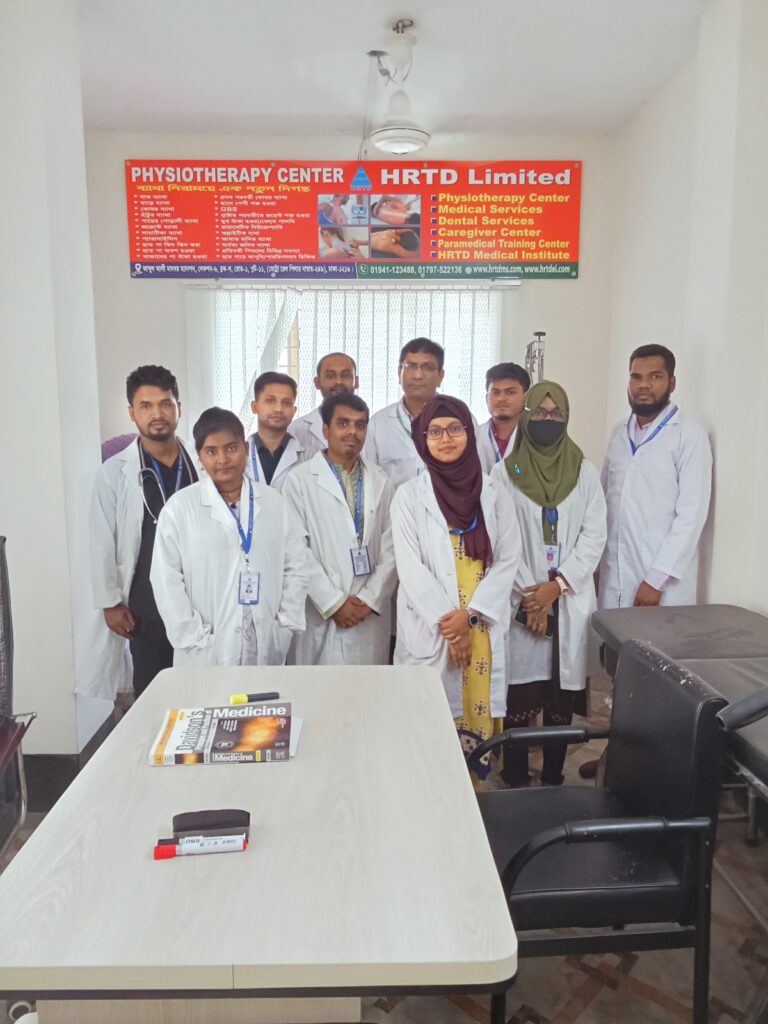
 HRTD Medical Institute
HRTD Medical Institute



